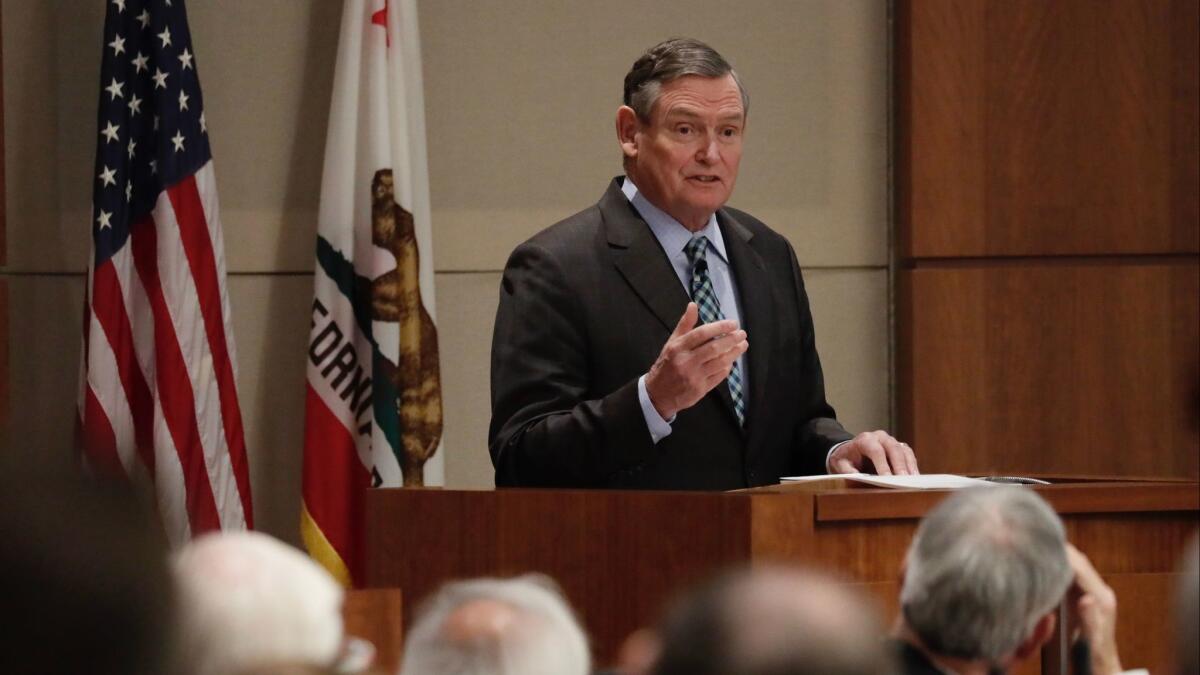Cal State trustees debate tuition increase, ‘unsustainable’ funding gaps at nation’s largest public university system

- Share via
Cal State University Chancellor Timothy P. White delivered a reality check Tuesday in his annual address to students, faculty and campus leaders, challenging “status quo” thinking and calling out “unsustainable” budget demands facing the nation’s largest public university system.
“It’s important to keep costs as low as possible for our students, while also understanding the reality that a quality education does take resources,” White said in his state of the university speech during a Board of Trustees meeting in Long Beach. But “the simple truth is that someone always pays — it’s who pays that has changed over time.”
Although Cal State has increased enrollment by 31,000 students since the recession and hired more than 700 tenure-track faculty in the last year, with 700 additional hires underway, the pressure to accommodate more students — while preserving the quality of education — continues to outpace the “incremental increases” in state funding, he said.
“These increases in support from the state are going in large part to the rising costs of healthcare or other mandated and inflationary costs that eat away at progress that we’ve made,” White said.
These remarks come as university trustees debated a controversial proposal to raise tuition for a second consecutive year. In-state students would see an increase of $228, bringing the annual cost to $5,970. Full-time nonresident students would see tuition increase by about $900, bringing the annual total to $12,780.
Based on Gov. Jerry Brown’s current 2018-19 budget plan, administrators expect to get only $92.1 million of the $263 million they say they need in additional state funding — which would bring Cal State’s total annual operating budget to $6.8 billion.
A tuition increase, according to a proposal submitted to the Cal State Student Assn., would generate $90.5 million in new revenue, after taking into account additional financial aid costs.
Without either additional state funding or tuition revenue, trustees and campus leaders would have to make tough calls.
Ryan Storm, assistant vice chancellor for budget, walked trustees through a hypothetical scenario in which Cal State could scale back the $75 million they hoped to spend next year to improve graduation rates, hold off on spending $20 million to increase student enrollment and hit pause on building upgrades for a year (roughly $15 million).
Even with those reductions, there would still be a $61-million gap, Storm said. “The math just doesn’t work. We need to plan for the worst.”
The University of California, facing similar budget pressures, is also considering a tuition increase, and regents last week voted to put off a decision until May.
White also postponed a decision on a tuition hike until at least May, while the university lobbies for more state funding. But he acknowledged that the yearly budget impasse, which many say avoids dealing with long-term, systematic funding problems, is unsustainable.
The “low-hanging fruit” for cost-savings has been picked, budget administrators told trustees, including consolidating library subscriptions across the system’s 23 campuses, sharing technology and even an unprecedented partnership with the UC system to streamline operations and reduce costs in administrative areas that overlap.
“Efficiencies and cost reductions can only go so far,” White said. “Once you begin cutting into core functions, critical support areas, equipment and infrastructure, vital faculty or staff, then the drive for efficiency becomes a death spiral of lost quality.”
Some trustees raised the need for “real structural change.”
“We need a new approach. It seems crazy to me to run an institution of this size and complexity on this annual budgeting process… not knowing until June what money we’re going to have for the next academic year,” Trustee Jane W. Carney said.
She expects a report at the next trustees meeting, in March, on how revenue from this year’s tuition increase is being spent. No decision should be made, she said, until trustees have a better sense of how this money is helping students.
Student trustee Jorge Reyes Salinas agreed, sharing the many roadblocks that still exist for students, such as getting into the classes they need to graduate on time.
“There needs to be more transparency on where exactly that money is going,” he said.
He joined others in calling on administrators to put more pressure on legislators, not students — many of whom are juggling numerous jobs, while struggling to pay rent and eat three meals a day — to fill the budget gap.
Kevin Wehr, a sociology professor at Sacramento State and secretary of the California Faculty Assn., noted the 31,000 fully qualified students who were rejected last year because their desired campus was at capacity, as well as past audits that found that Cal State hires too many managers and needs better budget oversight.
“A budget is a moral document that reveals what an institution or society really cares about,” Wehr said. “What is the board actually doing to resurrect a commitment to public higher education in California?”
Follow @RosannaXia for more education news
More to Read
Sign up for Essential California
The most important California stories and recommendations in your inbox every morning.
You may occasionally receive promotional content from the Los Angeles Times.














